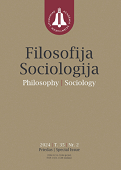Post-Human and Trans-Human in the Future Perspective of the Humanity
Post-Human and Trans-Human in the Future Perspective of the Humanity
Author(s): Oksana Chursinova, Maria SinelnikovaSubject(s): Special Branches of Philosophy, Philosophy of Science, ICT Information and Communications Technologies
Published by: Lietuvos mokslų akademijos leidykla
Keywords: post-human; trans-human; self-organising structure; post-humanism; technology; machine;
Summary/Abstract: The article considers the issue of chnging the main anthropic characteristics of a human under the influence of the rapid development of the latest technologies. Such changes cause the need to revise the usual interpretation of the concept of ‘human’, which is gradually being substituted by the currently popular concepts of ‘trans-’ and ‘post-human’. These concepts are favourably perceived by the techno-optimists, who believe that the latest technologies will allow us to create people who will be physically, intellectually and spiritually superior to the people of today, although they admit that this may lead to greater social inequality. The article states that the post-human potential is too ambiguous to clearly outline it. On the one hand, it opens up unprecedented possibilities, which can be considered the highest manifestation of human freedom, i.e. the ability to model a person according to one’s vision. On the other – there is a real threat to human existence itself, namely, the danger of technological capture of the potential for human improvement. Therefore, the task of the article is to outline the possible prospects for the formation and improvement of modern human identity under the conditions of its combination with the other, non-human species and the latest technologies. This is possible under the condition of acceptance of new possibilities for the post-human as the liberating force that overcomes the negativity and limitations of human nature. The comparative method and the method of analysis were used in the article.
Journal: Filosofija. Sociologija
- Issue Year: 35/2024
- Issue No: 1
- Page Range: 23-30
- Page Count: 8
- Language: English

